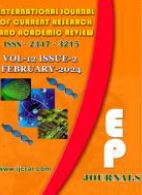Abstract Volume:12 Issue-2 Year-2024 Original Research Articles
 |
Online ISSN : 2347 - 3215 Issues : 12 per year Publisher : Excellent Publishers Email : editorijcret@gmail.com |
Bacterial DNA recombination, horizontal gene transfer, occurs by three basic mechanisms. Gene transfer by cell-to-cell contact (conjugation); gene transfer via virus particles (transduction), and bacterial cells take up free molecules of DNA (transformation). Transposable genetic elements (transposons, insertion sequences, integrons, and bacteriophage Mu) are segments of bacterial DNA that can move from one site to another site within or between genomes by a process called transposition. Recombination and transposable elements play important roles in the generation and transfer of new gene combinations. This results in the evolution of genetic variability in bacteria. This variation is due to mainly three strategies: (1) small local changes in the nucleotide sequence of the genome, (2) intragenomic reshuffling of segments of genomic sequences, and (3) the acquisition of DNA sequences from another organism. These alterations result in adaptation to novel ecological opportunities, acquisition of virulence genes, and drug resistance development. It needs due progressive attention for the evolution of virulent and drug-resistant varieties.
How to cite this article:
Tariku Geinoro and Wubshet Mulugeta. 2024. Bacterial DNA Recombination Events and Transposable Genetic Elements: Their Role in the Evolution of Bacterial Genetic Variability.Int.J.Curr.Res.Aca.Rev. 12(2): 57-66doi: https://doi.org/10.20546/ijcrar.2024.1202.007



Quick Navigation
- Print Article
- Full Text PDF
- How to Cite this Article
- on Google
- on Google Scholor
- Citation Alert By Google Scholar
